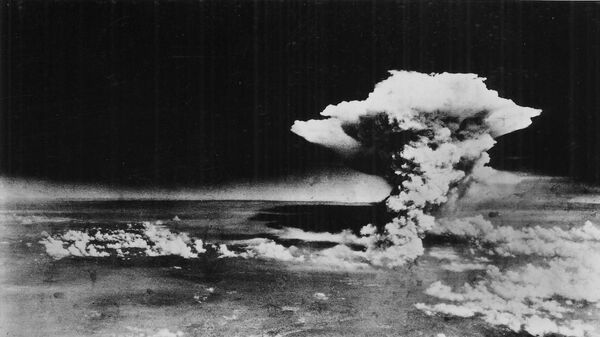On August 6, 1945, the US B-29 bomber Enola Gay dropped the 20-kiloton atomic bomb "Little Boy," which devastated most of Hiroshima and killed 140,000 people. Just a few days later, on August 9, 1945, another US bomber dropped the 21-kiloton atomic bomb "Fat Man" on Nagasaki, killing approximately 70,000 people and leaving thousands of others injured. The casualties would have been greater if the bomb hadn't missed its original target due to weather conditions.
Kevin Kamps, Radioactive Waste Specialist at the organization Beyond Nuclear, joined Radio Sputnik's Loud & Clear Wednesday to discuss the important anniversaries.
"The number of deaths and injuries are mind-boggling: 140,000 deaths in Hiroshima, a city of 360,000. Nagasaki — because the bomb didn't hit downtown exactly because there was cloud cover that interfered with the targeting — [resulted in] another 70,000 [being] killed. What an announcement of the atomic age that that was," Kamps told hosts John Kiriakou and Brian Becker.
"At first, the American people were filled with joy and relief that the war was over not long after the Nagasaki bomb, but as a book called ‘By The Bomb's Early Light' by Paul Boyer explained, that joy gave into fear because the American people realized within weeks, if not days, that if we can do that to somebody else, somebody else can do that to us. And sure enough, Russia had the bomb within four years," Kamps added.
According to Kamps, US estimates of American casualties during the first month of a US invasion of mainland Japan — before the bombs were dropped — were approximately 50,000, not 1 million.
"And the myth became that a million American lives were saved by dropping the bombs. That was not true. The truth is, the bombs were dropped to send a message to the Soviet Union where to get off. Billions of dollars in 1945 money had been spent on that [atomic] project, and the bombs were dropped to fulfill an experiment as well, to show some return on the so-called investment. If those billions of dollars had been spent on ships, tanks and guns in the US military instead of atomic bombs, would the war have ended sooner because of that?" Kemps asked.
Another common myth is that the bombs ended World War II, Kamps said.
"But no, it was the threat of a Soviet military invasion that ended World War II. The Japanese had been firebombed by the Americans for months already, and that lends a lot more to the theory that these atomic bombings were tests, because they [the Americans] were saving some cities to use these bombs against, and they wanted to see full on what the effects were. So Hiroshima was preserved for that purpose," Kemps told Radio Sputnik.
"Another irony about Nagasaki is that it is the primary Christian city in Japan. Christians had missions in Nagasaki for a long time. There was a cathedral in Nagasaki. The boxcar plane that dropped the bomb and the crew were blessed by a Christian priest before the mission," Kemps added.
During a Monday ceremony at the Hiroshima Peace Memorial Park, Japanese Prime Minister Shinzo Abe gave a speech assuring that Japan, as the only country that has experienced an atomic bombing, will champion the reduction of nuclear weapons in the world, Sputnik reported Monday.
"Our nation, while maintaining our [non-nuclear weapons] principles, will patiently work to serve as a bridge between the [nuclear and non-nuclear states] and lead efforts by the international community to reduce nuclear weapons," Abe said.
Mayor of Hiroshima Kazumi Matsui warned nuclear states against repeating the mistakes of the past during a speech at the ceremony, urging all countries to join the UN Treaty on the Prohibition of Nuclear Weapons.
Those who survived the bombings were not left unscathed either — around 200,000 people were irradiated and either died of or suffered from related diseases for the rest of their lives, raising the casualties to almost half a million, according to some estimates, Sputnik reported Monday.





